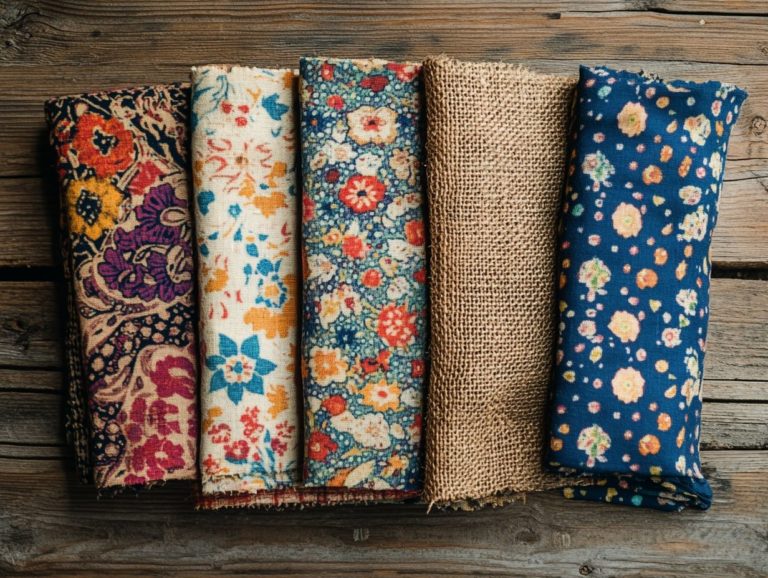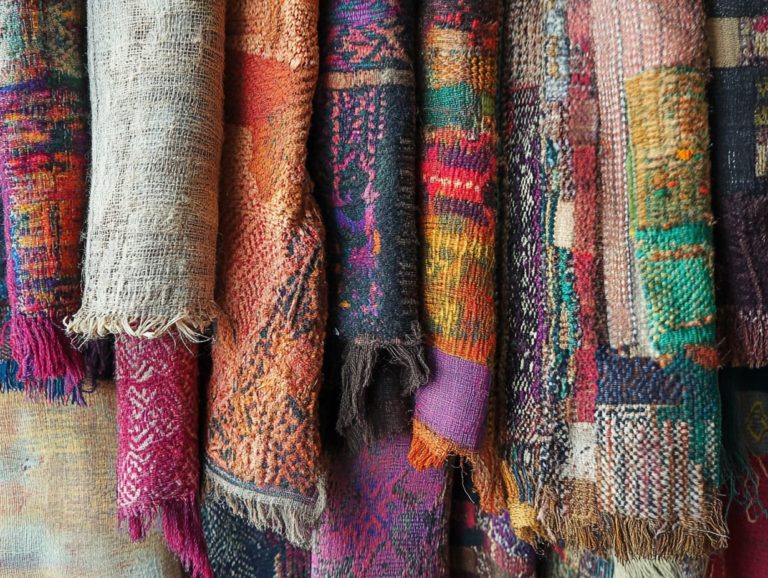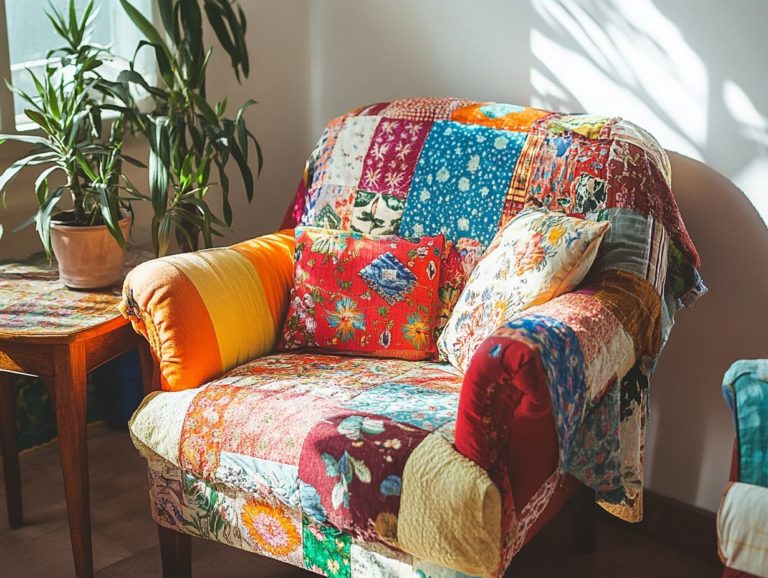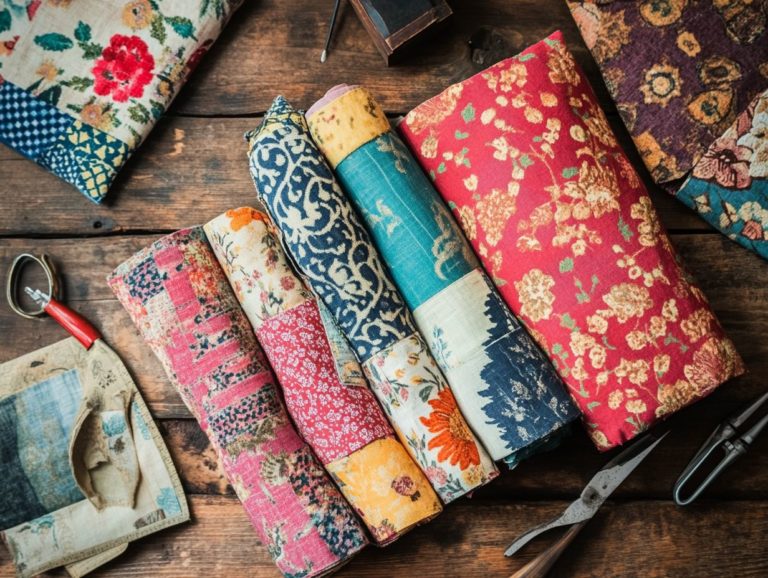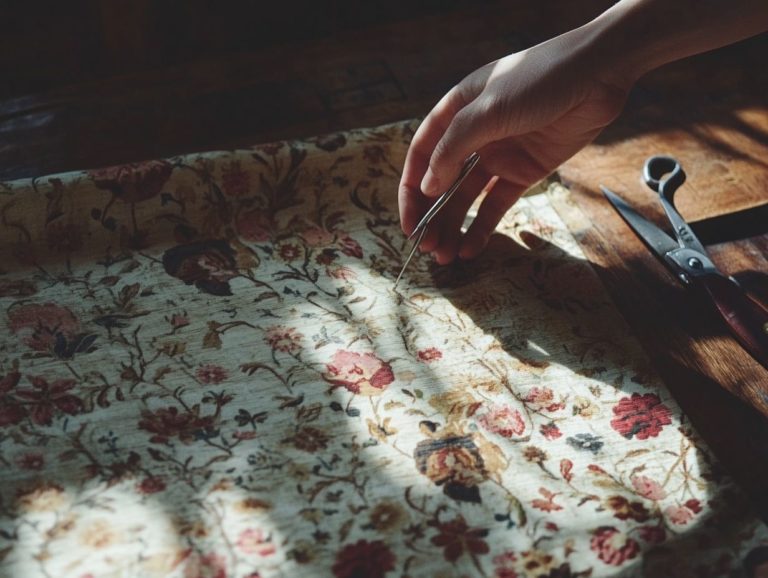The Best Vintage Fabric Restoration Techniques
Vintage fabrics carry with them the rich stories of the past, embodying artistry and craftsmanship that time often forgets. Restoring these treasures is not merely an act of preservation; it enhances their intrinsic value and significance. Among these are antique textiles that tell unique stories.
It’s crucial to recognize common types of textile damage and learn specific restoration techniques suited for materials such as silk, lace, and wool. There s a wealth of knowledge to uncover regarding handling textiles with care.
Whether you lean toward a DIY approach or are contemplating professional assistance, this guide will equip you with vital tips and techniques to rejuvenate your vintage fabric collection.
Contents
- Key Takeaways:
- The Importance of Vintage Fabric Restoration
- Common Types of Damage to Vintage Fabric
- Restoration Techniques for Different Types of Fabric
- DIY vs Professional Restoration
- Tips for Maintaining Restored Vintage Fabric
- Frequently Asked Questions
- What are the best vintage fabric restoration techniques?
- How should I handle delicate vintage fabrics during restoration?
- Can I restore vintage fabrics myself or should I hire a professional?
- What are some common mistakes to avoid when restoring vintage fabrics?
- How can I prevent further damage to vintage fabrics?
- Are there any special considerations for restoring vintage silk fabrics?
Key Takeaways:
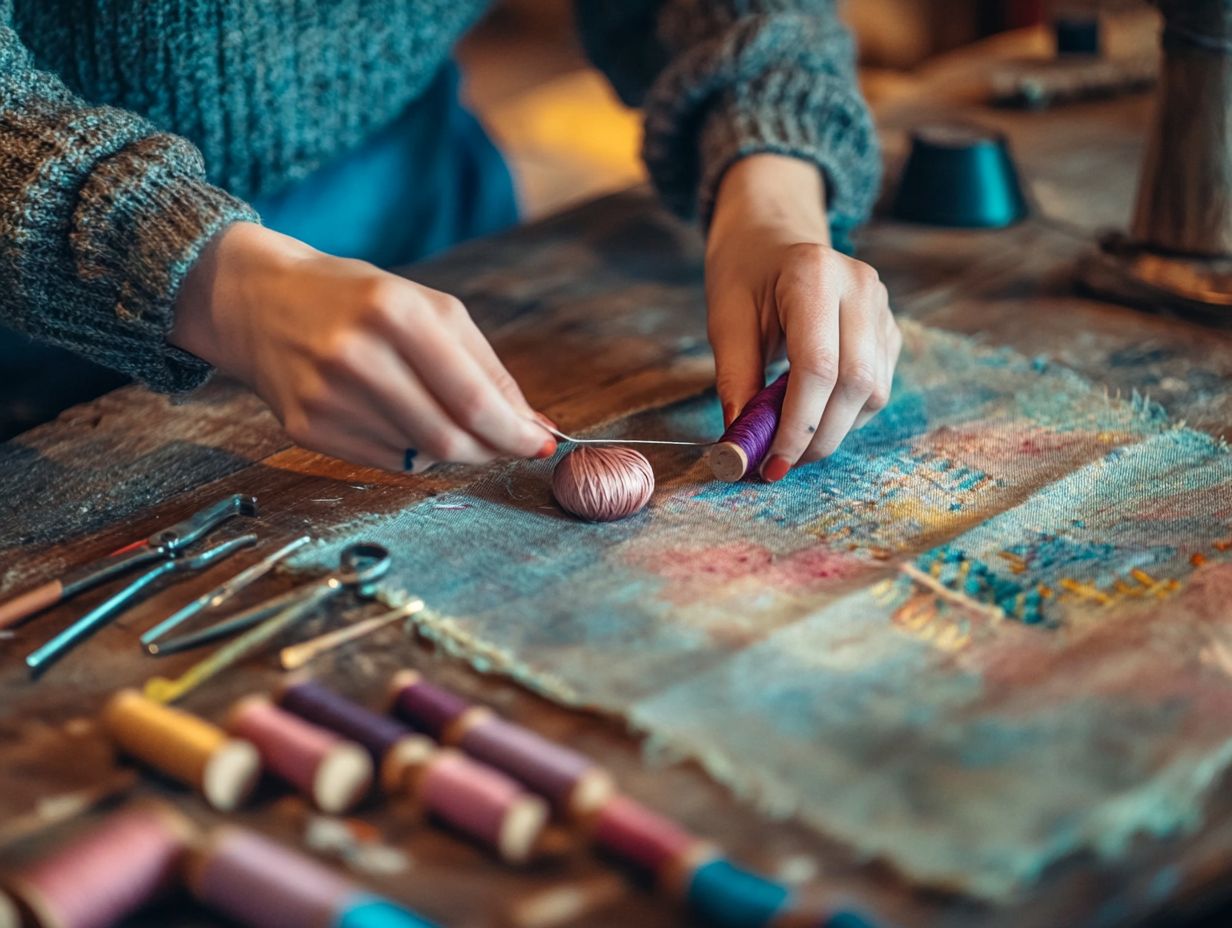
- Preserve the history and value of vintage fabric through restoration techniques.
- Identify and assess damage to vintage fabric before choosing the appropriate restoration method.
- Seek professional help for delicate fabrics such as silk, lace, embroidery, wool, cashmere, and vintage fabrics.
The Importance of Vintage Fabric Restoration
Vintage fabric restoration is essential not only for preserving the aesthetic charm of your cherished items but also for keeping the stories safe woven into antique textiles. Regarding carefully made items like Victorian samplers and 18th-century embroidery, appreciating the importance of textile conservation as the practice of taking care of fabrics to keep them in good shape becomes paramount.
Each restoration effort you undertake is a tribute to the artistry embedded in these vintage fabrics. By implementing proper cleaning techniques, managing humidity levels, and employing UV protection, along with dusting and vacuuming practices, you can significantly enhance the longevity of these fragile textiles.
Valuing these practices ensures that you keep your connection to the past vibrant for future generations.
Preserving History and Value
Preserving antique textiles is essential for maintaining cultural heritage and the intrinsic value tied to historical artifacts, many of which have intricate Dutch embroidery or motifs from the 15th century and 17th century.
These exquisite fabrics act as tangible connections to the past, revealing the craftsmanship and artistry of their creators, such as the renowned Charles I and artists like Wenceslaus Hollar. Each piece tells a story reflecting societal norms, fashions, and technological advancements that illustrate the evolving lifestyles across generations.
By prioritizing textile conservation, you and your organization contribute significantly to the preservation of these historical treasures for future generations. Your efforts in restoring and safeguarding vintage fabrics cultivate a deeper appreciation for the artistry involved in their creation while also championing practices that promote sustainability and ethical stewardship of material culture.
Common Types of Damage to Vintage Fabric
Understanding the common types of damage that can afflict vintage fabric is essential for effective restoration. These delicate pieces are often vulnerable to environmental conditions like humidity and light exposure, which can lead to irreversible damage, especially when stored improperly with inadequate storage methods.
Improper storage methods and pest infestations can further complicate the situation. Fabrics adorned with intricate Dutch embroidery, Victorian samplers, or 15th-century motifs demand special care to prevent deterioration.
By proactively addressing these concerns such as implementing pest prevention strategies and utilizing UV protection you can significantly prolong the life of these fragile textiles.
Identifying and Assessing Damage
Identifying and assessing damage to fragile textiles is a careful process. It requires you to examine the fabric for signs of wear, discoloration, or other forms of textile damage.
Your careful evaluation begins with a thorough visual inspection. You ll examine the fabric closely to spot any frayed edges, fading patterns, or stains that might not be immediately obvious. Using cotton gloves during handling is essential. By gently touching the fabric, you can detect variations in texture that may signal areas of weakness or ongoing deterioration.
Utilizing appropriate lighting and magnification tools is crucial. These tools help unveil issues like fiber breakage or insect damage that might escape the naked eye, especially when working with delicate fabrics.
By combining these observational techniques with your knowledge of cleaning methods whether dry cleaning or gentle wet cleaning and conservation treatments like patching or stabilization, you’ll gain a comprehensive understanding of the fabric’s condition. This insight will guide you in executing effective restoration efforts, including mending techniques that can vary based on the fabric type.
Restoration Techniques for Different Types of Fabric

Restoration techniques for various types of fabric differ significantly. They are tailored to meet the unique needs of each textile be it the soft beauty of silk, the robust resilience of wool, or the fragile beauty of lace.
Grasping the characteristics of fabrics like cashmere and lace is essential for effective restoration. Techniques such as cleaning, mending, and conservation treatments can breathe new life into vintage items, ensuring their timeless beauty endures through processes like upholstery care. For more detailed guidance on this, check out transforming vintage finds: DIY restoration tips.
Professional cleaners often use specialized methods. They meticulously address every detail from dusting and vacuuming to upholstery care with unparalleled precision.
Cleaning and Repairing Silk
Cleaning and repairing silk, a delicate fabric, demands specialized knowledge and techniques to ensure that the restoration process doesn t cause any harm.
One of the first things you should do when caring for silk is to conduct a color-fastness test. This test involves lightly dampening a small, inconspicuous area with water and gently blotting it with a white cloth to check for any color transfer. Be sure to protect surrounding areas with polythene. If you notice any bleeding, it s advisable to opt for dry cleaning to maintain the hue and texture.
For minor repairs, using silk adhesives or stitching with silk thread can be quite effective, especially with Victorian samplers and other delicate items. Employing specialized mending techniques is crucial to reinforcing the fibers while preserving their delicate nature, particularly in fabrics like lace and wool.
This approach allows the silk to retain both its aesthetic charm and structural integrity, ensuring it looks as stunning as ever.
Restoring Lace and Embroidery
Restoring lace and embroidery calls for delicate procedures that ensure these vintage fabrics retain their intricate designs and structural integrity.
Undertaking this task requires a blend of patience and expertise, as even the slightest mishap can result in irreversible damage. You ll want to begin with a careful inspection to pinpoint areas in need of repair, like frayed threads, discolored sections, or any damage from insect infestations.
Techniques such as needle weaving, where matching fibers are meticulously sutured into the fabric, and darning, which repairs holes while preserving original patterns, are commonly utilized.
Gentle cleaning methods are essential. Soaking in mild soaps, using specialized fabric cleaners, or placing lavender sachets to deter pests helps lift embedded dirt without causing harm. A thoughtful approach is crucial in preserving the beauty and history woven into lace and embroidery, particularly with the revival of vintage fabrics in contemporary decor.
Rejuvenating Wool and Cashmere
Rejuvenating your wool and cashmere pieces requires a careful method, as these luxurious fabrics demand specialized care to prevent any damage during the restoration process, which may include handling textiles with utmost care.
These materials are naturally delicate, necessitating thoughtful attention to preserve their soft texture and vibrant hues while considering the implications of humidity and light exposure. Regarding cleaning, a gentle hand wash with cold water and a mild detergent often does the trick for home care. However, for a more thorough treatment, turning to professional cleaners with expertise in textile conservation, particularly those skilled in upholstery care, can be invaluable. They utilize eco-friendly solvents and gentle agitation techniques to safeguard the fibers, ensuring your cherished garments remain in pristine condition and are often adept at addressing issues like pest prevention.
Understanding proper storage is crucial. By using breathable bags, acid-free tissue, and steering clear of direct sunlight, you can significantly extend the lifespan of your wool and cashmere treasures.
DIY vs Professional Restoration
When considering vintage fabric restoration, the decision between tackling it on your own or enlisting professional cleaners can significantly influence the results, particularly for delicate textiles that necessitate specialized attention and techniques like dry cleaning.
While diving into DIY restoration can be a gratifying journey, it carries the inherent risk of inadvertently causing more harm if the right cleaning techniques aren’t employed. Grasping the nuances of textile conservation is essential; certain pieces may truly require the skill of professionals to safeguard their longevity and intrinsic value. For those interested, exploring vintage fabric preservation tips can provide valuable insights.
When to Seek Professional Help

It’s essential to know when to seek professional help for vintage fabric restoration to keep your treasures safe! Recognizing the signs that signal the need for expertise can significantly enhance the longevity of your cherished pieces, especially when it comes to fragile textiles that require immediate attention. For example, if a beloved vintage dress starts showing signs of fading or fraying, it s vital to consider the intricate nature of the materials involved.
Professional restorers bring specialized knowledge and advanced techniques to the table, allowing them to effectively address unique challenges like dye loss or delicate stitching repairs. By engaging experts, you ensure that the appropriate cleaning methods are used while safeguarding against common pitfalls, such as harsh chemicals that could worsen the condition of your valuable items. For those interested in DIY restoration, it’s beneficial to explore the best vintage furniture restoration supplies to get started.
This level of care can transform an at-risk heirloom into a lasting treasure, preserving its beauty for generations to come.
Tips for Maintaining Restored Vintage Fabric
Maintaining restored vintage fabric is crucial for ensuring its longevity and preserving the exquisite beauty of antique textiles. It involves adhering to specific care techniques and employing proper storage methods.
You must understand how environmental conditions, such as humidity levels and light exposure, can affect the integrity of these delicate fabrics. By following the recommended practices, you can extend the life of your restored treasures, ensuring their stories endure for generations to come.
Proper Storage and Care Techniques
Proper storage and care techniques are paramount for preserving the exquisite condition of vintage fabrics and preventing deterioration from environmental factors.
To achieve this, you should store these delicate textiles in a climate-controlled environment that maintains humidity levels between 50-60%. This helps ward off mold growth and fabric degradation.
Utilizing breathable cotton storage bags will also protect against dust and pests. Additionally, keeping the fabrics away from direct light exposure is crucial to prevent fading and discoloration.
Regular inspections allow you to catch any infestations or damage early on, ensuring that these cherished pieces remain in pristine condition for generations to come.
Frequently Asked Questions
What are the best vintage fabric restoration techniques?
The best techniques include gentle hand washing, spot treatments, and mending with matching fabric. Steaming and storing in acid-free tissue paper also help preserve the fabric.
How should I handle delicate vintage fabrics during restoration?

Handle delicate fabrics with care. Avoid harsh chemicals and choose gentle methods like hand washing and steam cleaning.
Can I restore vintage fabrics myself or should I hire a professional?
Consider hiring a professional to ensure your fabrics are restored perfectly, especially if they are delicate or valuable. Experts know how to handle fabrics properly to avoid damage.
What are some common mistakes to avoid when restoring vintage fabrics?
Avoid using harsh chemicals and always test a small area first. Make sure to use color-safe detergent and store the fabric properly after cleaning.
How can I prevent further damage to vintage fabrics?
Store vintage fabrics in a cool, dry place away from direct sunlight. Handle them with clean hands and avoid harsh cleaning methods.
Are there any special considerations for restoring vintage silk fabrics?
Silk is delicate and requires extra care. Use gentle cleaning methods and keep it away from heat and sunlight. Never use bleach or harsh chemicals on silk.

